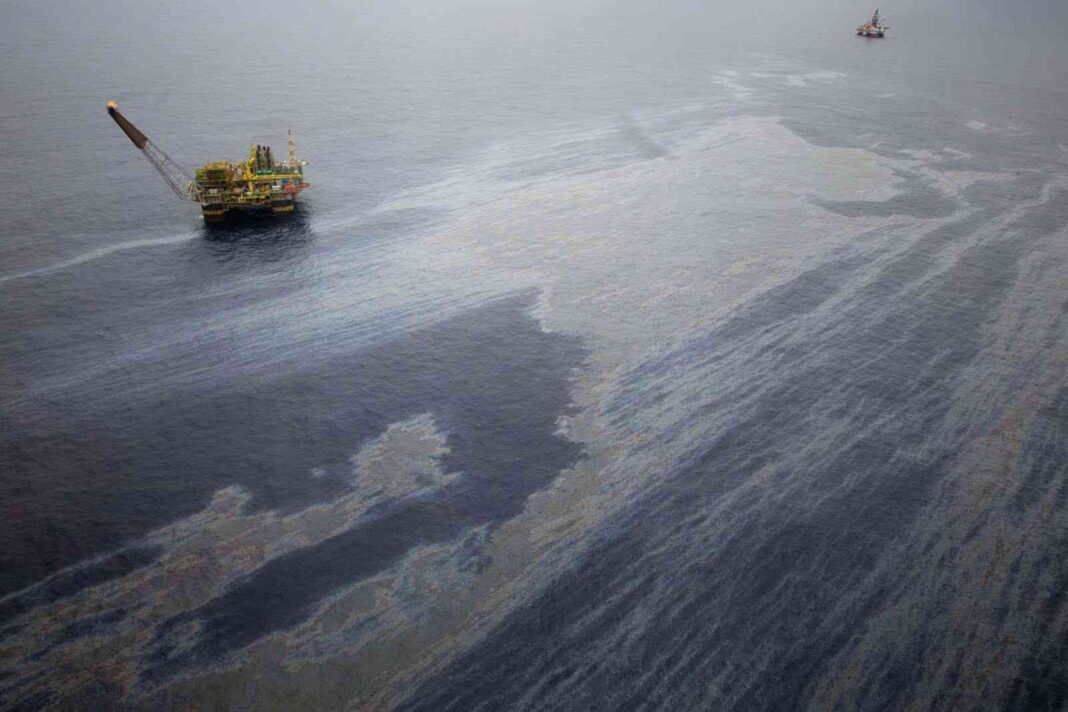A thick, oily sheen spread across the turquoise waters near Abu Redis in South Sinai on 4 May, alarming local communities and threatening one of Egypt’s most prized natural assets: the Red Sea coastline.
The leak is believed to have originated from either a marine source or an oil company operating in the vicinity. The Ministry of Environment responded, deploying a cleanup team and marine barriers to contain the slick, while investigations began into the source of the leak, suspected to be from a nearby oil facility or passing vessel.
Oil spills are a longstanding concern in the region. From 2017 to 2021, small-scale oil leaks were recorded on a near-monthly basis along Egypt’s Gulf of Suez coastline, according to a study by the National Authority for Remote Sensing and Space Sciences mapping oil pollution in the area during that period.
While recent high-profile incidents such as the May 2025 spill near Abu Redis and the December 2024 cargo ship leak off the coast of El Quseir have drawn renewed attention to the risks. Data shows no clear rise in oil spill frequency or severity in Sinai, but points to ongoing, recurring pollution with consequences already visible along the coast.
Beaches once known for their pristine sands are now marred by tar balls and oil. Their shores have darkened, becoming hazardous for wildlife and local communities alike.
Oil contamination ravages local fisheries, wiping out entire species, such as the hawksbill turtle, sea cucumbers, mangrove trees, and destroying essential fishing gear, effectively dismantling the primary livelihood of countless coastal families, with recovery potentially stretching into decades.
The Red Sea, home to some of the world’s last thriving coral reefs, including rare, heat-resistant “super corals”, faces ongoing pollution from oil operations, particularly at facilities like the Ras Shukeir terminal. At the terminal, thousands of cubic meters of toxin-laden wastewater are dumped daily, releasing oil, grease, and heavy metals into the sea.
In towns like Ras Ghareb, in the northernmost part of the Red Sea governorate, communities report that persistent oil pollution has turned the sea toxic, raising concerns over public health and food safety as tainted seafood risks making its way to family tables. The result is a deepening cycle of environmental degradation and economic distress, with long-term effects on Egypt’s coastline and its people.
Oil spills, an ever-present environmental risk to livelihood and species, are closely linked to the growth of Egypt’s energy and tourism sectors, posing significant threats to both ecosystems and local economies.
Tourism-heavy areas often depend on fossil fuels to meet rising energy needs, increasing the risk of environmental harm such as oil spills, resulting in pollution, habitat loss, and resource strain. Oil spills from energy extraction and transport add to these risks by polluting coastal and marine ecosystems vital to tourism.
The Red Sea’s distinctive marine ecosystem, which has over 1,200 species of fish and pristine coral reefs, vital to tourism and the livelihoods of coastal communities, has faced repeated threats. The Jebel Al-Zayt oil spill, north of the Red Sea, in 2010 contaminated approximately 160 kilometers of shoreline, exposing deficiencies in Egypt’s environmental response and transparency, even as it prompted a large-scale cleanup effort.
Although Egypt maintains a National Oil Spill Contingency Plan and agencies such as Petrosafe remain on constant alert, energy expert Justin Dargin from the University of Oxford cautions that these efforts fall short of matching the scale of industrial activity and the ecological vulnerability of the region.
The contingency plan is overseen by the Egyptian Environmental Affairs Agency (EEAA), which leads Egypt’s environmental oversight. The plan operates on a tiered response system: minor spills are handled by local port authorities and oil companies, while more serious incidents trigger joint action between the environmental agency and the Egyptian General Petroleum Corporation. In cases of major emergencies, command shifts to the National Response Centre in Alexandria, operating under the agency’s leadership.
Additionally, each coastal governorate in Egypt is tasked with managing onshore cleanup, while the EEAA provides operational oversight and technical support. Oil companies are also legally obligated to maintain their contingency plans and equipment, particularly for spills occurring at exploration or production sites.
In response to the recent incident, the Ministry of Environment sent an additional technical committee to the site, citing the area’s ecological importance, to monitor cleanup efforts and ensure strict compliance with environmental regulations.
Efforts to make Egypt’s tourism sector more sustainable are underway, with a focus on reducing energy and water use in Red Sea resorts and promoting stronger environmental practices. In parallel, the government is increasing investment in coastal renewable energy projects to reduce reliance on fossil fuels, amid the mounting concerns about balancing economic growth with environmental sustainability.


